WEEK 1: Lecture Introduction to Popular Music and Tin Pan Alley 
What is popular music anyway? How do we define popular? The Merriam-Webster Online Dictionary gives the following: Etymology: Latin popularis, from populus the people, a people
of or relating to the general public suitable to the majority: as
a. adapted to or indicative of the understanding and taste of the majority <a popular history of the war> b. suited to the means of the majority : inexpensive <sold at popular prices>
frequently encountered or widely accepted <a popular theory> commonly liked or approved <a very popular girl>
Not to worry. You will not have to remember these definitions. The chief indicator of popular music is . . . . .  That's right - the almighty dollar! That's right - the almighty dollar!
The most popular music makes the most $. At least that's how we judge in our culture. In other words, if we buy it, they will make more. If we don't, it will disappear. So . . . . We will study many different (and some quite similar) genres of popular music. Some you will like and some you won't. But, you can bet that there are enough people who like each one in order to make it popular by spending their $. Let's check it out. Follow this link and see how many of these albums you have. Top Selling Record Albums of All Time Were you surprised? Do you know what the most popular song of all time is???? Drum roll, please. 
THE Most Popular Song Bet you didn't guess it! 
OK, we have to do some history stuff: Our popular music in America came from either Europe (mostly English pubs and Irish folksongs) or Africa (mostly West Africa as a result of the slave trade). Nearly all of it developed in the Southeast (agriculture, Charleston as a major slave trade port, New Orleans as an international "party" city). The result is an amalgamation* and synthesis* of musical elements to form uniquely American sounds that have consequently influenced the music of the rest of the world. Impressive.  Speaking of influence, now that I have offered a simple explanation, it would be wise for all of us to avoid over-simplifying the evolution of "American" music. That which we claim as American has a very diverse history and is a result of many influences. Consider the words of Ralph Linton in an essay written in 1937 entitled "One Hundred Per-Cent American." He follows the proverbial American through his day which ends with this scenario: Meanwhile, he reads the news of the day, imprinted in characters invented by the ancient Semites by a process invented in Germany upon a material invented in China. As he scans the latest editorial pointing out the dire results to our institutions of accepting foreign ideas, he will not fail to thank a Hebrew God in an Indo-European language that he is one hundred percent (decimal system invented by the Greeks) American (from Americus Vespucci, Italian geographer).
So really, how far back do we have to go for the whole truth? 
Where shall we begin? Your textbook doesn't go quite that far back, but certainly before America was called "America." Be sure and read the part about the troubadours on pages 3 and 4. By the way, did I mention that any assigned reading is fair game for questions on the exam? Bwa - ha - ha !!!!!  Oops! My alter ego slipped out. But you have nothing to fear if you read the assigned material. Since $ is our measure, we will go back to the point in our country in which it became a significant factor with regard to popular music. $ 1789: the newly ratified Constitution of the United States included a copyright act that protected printed materials $ 1789: a ban on "theatrical activities" was lifted $ early 1800s: parlor songs became popular, creating a demand for sheet music $ c. 1830: pianos began to be mass produced (instead of made one at a time by hand) making them much more affordable
Every good old American middle class home would soon have a piano and hopefully someone to play it. If not, player pianos became very popular as well. There was a demand for sheet music to the popular tunes of the day. There was incentive ($) for songwriters to compose songs and Voila! The American Popular Music industry was born!

MINSTREL SHOWS 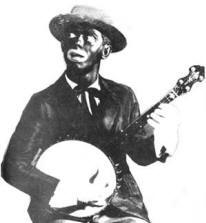
In the mid 19th-century, entertainment was definitely not politically correct. It was popular to parody any ethnic or immigrant group. Blackface songs and skits were common as well as stereotypical associations of Jews, Italians, Germans, French, Chinese, and others. The importance of minstrel shows to popular music was that some of the African elements that have influenced our popular music were made known through this forum. Check this link for additional information: Black Minstrelsy 1830-1852
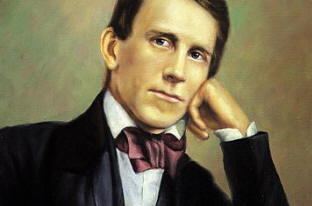 | The greatest American song composer of the 19th Century was Stephen Collins Foster (1826-1864) Here are a few of his songs: Beautiful Dreamer Camptown Races Jeannie with the Light Brown Hair Massa's in the Cold, Cold Ground My Old Kentucky Home Oh! Susanna Old Folks at Home listen |
any of those ring a bell? He was also important because he began to break away from European traditions and to use a more distinctly "American style. He combined parlor songs and black American folksongs. He died when he was only 38.

VAUDEVILLE 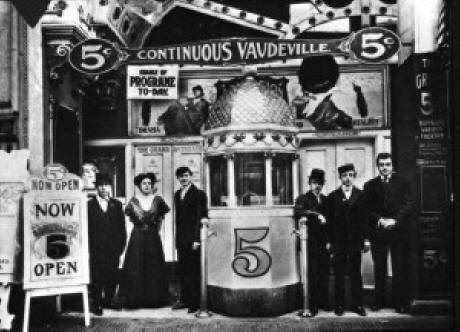
In the late 19th century a new form of entertainment came along - Vaudeville. Literally anything could be a vaudeville act. Check these out. Be sure to watch the first one more than half through. That's when the real fun begins.
Vaudeville Act: Hadji Ali Vaudeville Act Animal Tricks Vaudeville Act Acrobats Vaudeville Act Contortionists Since every vaudeville show would have a singer, the market for popular songs continued to increase. It wasn't MTV, but in its day, it was all the rage! Many of the popular songs were known as parlor songs.
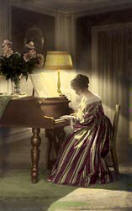 | Parlor songs were very popular. They were written for amateurs, so they were easy to perform and were often very sentimental. The first million seller in the United States was a parlor song written in 1892 called "After the Ball" listen by Charles K. Harris A little maiden climbed an old man’s knees— Begged for a story: "Do uncle, please! Why are you single, why live alone? Have you no babies, have you no home?" "I had a sweetheart, years, years ago, Where she is now, pet, you will soon know; List to the story, I’ll tell it all: I believed her faithless after the ball.“ ”Bright lights were flashing in the grand ballroom, Softly the music playing sweet tunes. There came my sweetheart, my love, my own, ‘I wish some water; leave me alone.’ When I returned, dear, there stood a man Kissing my sweetheart as lovers can. Down fell the glass, pet, broken, that’s all— Just as my heart was after the ball.“ ”Long years have passed, child, I have never wed, True to my lost love though she is dead. She tried to tell me, tried to explain— I would not listen, pleadings were vain. One day a letter came from that man; He was her brother, the letter ran. That’s why I’m lonely, no home at all— I broke her heart, pet, after the ball." Chorus: After the ball is over, after the break of morn, After the dancers' leaving, after the stars are gone, Many a heart is aching, if you could read them all— Many the hopes that have vanished after the ball. |
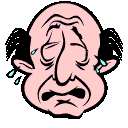 A real tearjerker, huh? A real tearjerker, huh?
I guess Mr. Harris cried all the way to the bank . . .  By the way, parlor songs were typically written in strophic form. Strophic just means same tune different words - like a song that has different verses. Sometimes a strophic song has a chorus (the part that repeats each time), but not always. By the way, parlor songs were typically written in strophic form. Strophic just means same tune different words - like a song that has different verses. Sometimes a strophic song has a chorus (the part that repeats each time), but not always.
Think of the song "Jingle Bells." It has several verses and a chorus that repeats between each verse. This is strophic. "Silent Night" has no chorus, just different words for each verse. This is also strophic. 
TIN PAN ALLEY Well, when the vaudeville acts and minstrel shows started touring, the demand for sheet music increased even more. New York became the center for those songwriters who were working hard to produce the songs to make the sheet music that everyone wanted to buy. The music business was driven by publishers. There was a particular street that became known for the sounds that floated out the windows of its buildings. As the music publishing business grew, the mixture of the pianos and singers from the open windows above the street were described as sounding like crashing tin pans. At this time, performers did not usually write their own songs. Songwriters would crank out the hits to be sung by the current popular singers and in turn, the publishers would crank out the sheet music! 
Tin Pan Alley was a force in American popular music until the Great Depression when the sale of sheet music dropped off and radio began to supply a great deal of America's thirst for popular music. The development of radio helped to form a national audience for music. Here's a link to more info about Tin Pan Alley. But the term Tin Pan Alley is still used to denote the musical establishment in the United States, no matter where the buildings are! 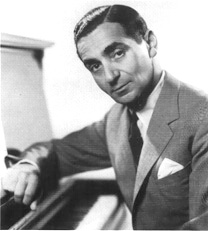 | One of the most successful of the Tin Pan Alley songwriters Irving Berlin (1888-1989) WOW Here are a few of his songs: White Christmas God Bless America A Pretty Girl is Like a Melody Alexander's Ragtime Band listen Easter Parade Anything You Can Do, I Can Do Better Blue Skies Puttin' on the Ritz listen |
His name was originally Israel Baline. He didn't even read much music at all, but composed over 3,000 songs. He composed by playing on the black keys of the piano. Recordings The phonograph was invented by Thomas Edison in 1877. 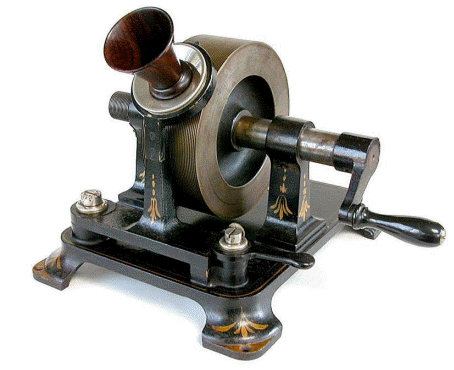
The basic concept of the recording was that a horn concentrated the vibrations of the sounds down to the point of a needle which etched them into wax. The phonograph could not record very soft sounds, so singers had to project their voices. They would "belt out" the notes and we refer to singers with that style of projection as belters. In the mid 1920s, the microphone was invented and the style of popular singing changed. Enter the crooners . . . They didn't write the songs they sang; they added their own style. Consequently, the song was the important thing and the more performers who performed the same song, adding their own style, the better! 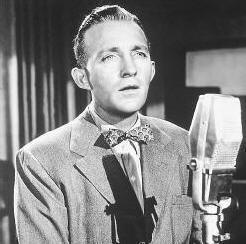 Bing Crosby America's Favorite Uncle "White Christmas" | 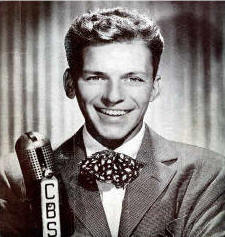 Frank Sinatra "Under My Skin" listen | 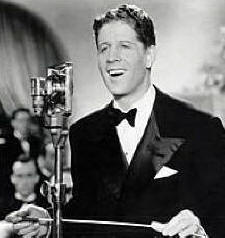 Rudy Vallee |
Theirs was a much more intimate style - much better for love songs. They were "dreamy" - they were heartthrobs. 
These guys would rule until Rock & Roll 

 | *amalgamation: a consolidation or merger, as in two or more corporations *synthesis: the combining of separate elements or substances to form a coherent whole |

Created and maintained by Vicky V. Johnson |